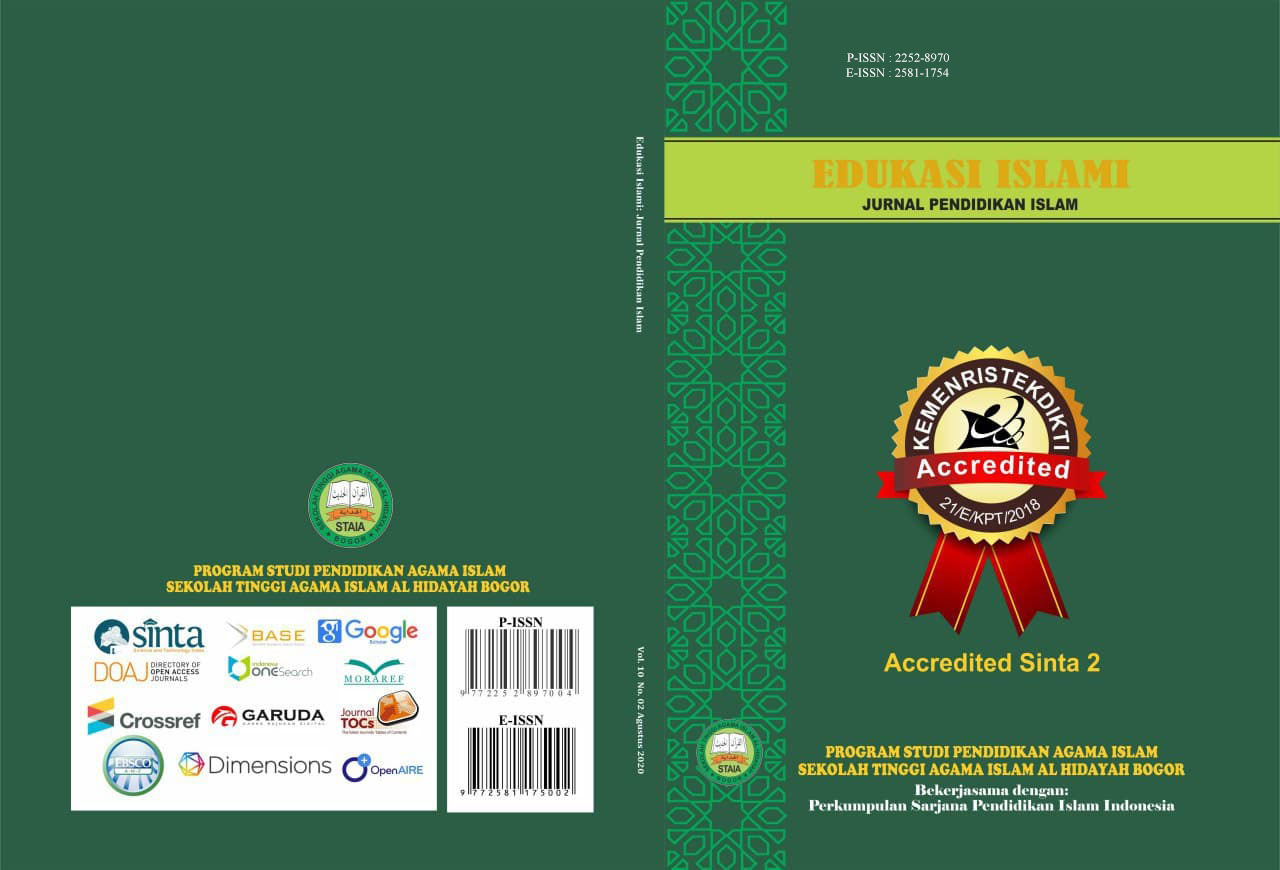Educational Innovation In Vocational Schools Humanistic-Religious Education Theory Perspective: The Use Of Vlogging As A Project-Based Learning Product
DOI:
https://doi.org/10.30868/ei.v12i001.5795Keywords:
educational innovation, humanistic-religious education theory, vlogging, project-based learning productsAbstract
References
Abayadeera, N., & Watty, K. (2016). Generic skills in accounting education in a developing country: Exploratory evidence from Sri Lanka. Asian Review of Accounting, 24(2), 149–170. https://doi.org/10.1108/ARA-03-2014-0039
Agarwal, S., & Chintranshi, J. (2002). Faculty Perceptions of Business Communication Skills and Needs of Management Students. Electronic Journal of Knowledge Management.
Aji, C. A., & Khan, M. J. (2019). The Impact of Active Learning on Students’ Academic Performance. Open Journal of Social Sciences. https://doi.org/10.4236/jss.2019.73017
Alfiyanto, A., Rijal, S., & Silahuddin, S. (2023). The Concept of Islamic Education Based on Religious Humanism Said Nursi’s Perspective. Journal on Education, 5(3), 9552–9562. https://doi.org/10.31004/joe.v5i3.1410
Bhuyan, J., Wu, F., Thomas, C., Koong, K., Hur, J. W., & Wang, C. hsuan. (2020). Aerial Drone: an Effective Tool to Teach Information Technology and Cybersecurity through Project Based Learning to Minority High School Students in the U.S. TechTrends. https://doi.org/10.1007/s11528-020-00502-7
Boissy, A., Windover, A. K., Bokar, D., Karafa, M., Neuendorf, K., Frankel, R. M., Merlino, J., & Rothberg, M. B. (2016). Communication Skills Training for Physicians Improves Patient Satisfaction. Journal of General Internal Medicine. https://doi.org/10.1007/s11606-016-3597-2
Bradford, M. (2005). Motivating Students through Project-Based Service Learning. T.H.E. Journal.
Bryson, C., & Hand, L. (2007). The role of engagement in inspiring teaching and learning. Innovations in Education and Teaching International. https://doi.org/10.1080/14703290701602748
Council. (2012). A framework for K-12 science education: Practices, crosscutting concepts, and core ideas. A Framework for K-12 Science Education: Practices, Crosscutting Concepts, and Core Ideas, 1–385. https://doi.org/10.17226/13165
Dreon, O., Kerper, R. M., & Landis, J. (2011). Digital Storytelling: A Tool for Teaching and Learning in the YouTube Generation. Middle School Journal. https://doi.org/10.1080/00940771.2011.11461777
Du-Babcock, B. (2006). Teaching business communication: Past, present, and future. In Journal of Business Communication. https://doi.org/10.1177/0021943606288775
Eckersley, M. (2016). Using Drama to Develop Communication Skills in the 21st Century Classroom. International Journal of Bilingual & Multilingual Teachers of English. https://doi.org/10.12785/ijbmte/040106
Hasan, S., Tarazi, H. M. K., & Hilal, D. A. H. (2017). Enhancing student communication skills through Arabic language competency and simulated patient assessments. American Journal of Pharmaceutical Education. https://doi.org/10.5688/ajpe81476
Jenkins, J. S. (2017). The effectiveness of project-based learning on mathematics proficiency with african american students. https://ursa.mercer.edu/handle/10898/5067
Klibi, M. F., & Oussii, A. A. (2013). Skills and Attributes Needed for Success in Accounting Career: Do Employers’ Expectations Fit with Students’ Perceptions? Evidence from Tunisia. International Journal of Business and Management. https://doi.org/10.5539/ijbm.v8n8p118
Krajcik, J., McNeill, K. L., & Reiser, B. J. (2008). Learning-goals-driven design model: Developing curriculum materials that align with national standards and incorporate project-based pedagogy. Science Education. https://doi.org/10.1002/sce.20240
Lopez, E. (2004). McKeachie’s Teaching Tips: Strategies, Research, and Theory for College and University Teachers (review). The Review of Higher Education. https://doi.org/10.1353/rhe.2003.0066
Nurul, N. mawaridah, & Romelah, R. (2022). Teori belajar humanistik dalam perspektif religius. COMSERVA Indonesian Jurnal of Community Services and Development. https://doi.org/10.59141/comserva.v2i2.216
Peña-López. (2019). PISA 2018 Results. What school life means for students’ lives. OECD Publishing, III, 1–10. https://www.oecd.org/pisa/publications/PISA2018_CN_IDN.pdf
Rahayu, I., & Sukardi, S. (2021). The Development Of E-Modules Project Based Learning for Students of Computer and Basic Networks at Vocational School. Journal of Education Technology. https://doi.org/10.23887/jet.v4i4.29230
Roseman, J. E., Linn, M. C., & Koppal, M. (2008). Characterizing Curriculum Coherence. Designing Coherent Science Education: Implication for Curriculum, Instruction, and Policy.
Savage, R. N., Chen, K. C., & Vanasupa, L. (2009). Integrating project-based learning throughout the undergraduate engineering curriculum. In IEEE Engineering Management Review. https://doi.org/10.1109/EMR.2009.4804346
Sawyer, R. K. (2014). The Cambridge handbook of the Learning Sciences, second edition. In The Cambridge Handbook of the Learning Sciences, Second Edition. https://doi.org/10.1017/CBO9781139519526
Shih, R. C. (2010). Blended learning using video-based blogs: Public speaking for students of English as a second language. Australasian Journal of Educational Technology. https://doi.org/10.14742/ajet.1048
Shin, N., Choi, S. Y., Stevens, S. Y., & Krajcik, J. S. (2019). The Impact of Using Coherent Curriculum on Students’ Understanding of Core Ideas in Chemistry. International Journal of Science and Mathematics Education. https://doi.org/10.1007/s10763-017-9861-z
Shivni, R., Cline, C., Newport, M., Yuan, S., & Bergan-Roller, H. E. (2021). Establishing a baseline of science communication skills in an undergraduate environmental science course. International Journal of STEM Education, 8(1). https://doi.org/10.1186/s40594-021-00304-0
Snelson, C. (2015). Vlogging about school on YouTube: An exploratory study. New Media and Society. https://doi.org/10.1177/1461444813504271
Taqwa, A. , & Sandi, V. N. (2019). Students’ Experiences of Using Vlogs to Learn English. Journal of Foreign Languange Teaching and Learning. https://doi.org/10.18196/ftl.4134
Thomas, J. W., & D, P. (2000). A REVIEW OF RESEARCH ON PROJECT-BASED LEARNING. Learning.
Wahyuni, L. M., Masih, I. K., & Mei Rejeki, I. N. (2018). Communication Skill Attributes Needed for Vocational Education enter the Workplace. Journal of Physics: Conference Series. https://doi.org/10.1088/1742-6596/953/1/012111
Wood, D. (2009). Challenges to strengthening the teaching and research nexus in the first-year undergraduate curriculum. International Journal of Learning. https://doi.org/10.18848/1447-9494/cgp/v15i12/46051
Downloads
Published
Issue
Section
Citation Check
License
Authors who publish with this journal agree to the following terms:
- Authors retain copyright and grant the journal right of first publication with the work simultaneously licensed under a Creative Commons Attribution License that allows others to share the work with an acknowledgment of the work's authorship and initial publication in this journal.
- Authors are able to enter into separate, additional contractual arrangements for the non-exclusive distribution of the journal's published version of the work (e.g., post it to an institutional repository or publish it in a book), with an acknowledgment of its initial publication in this journal.
- Authors are permitted and encouraged to post their work online (e.g., in institutional repositories or on their website) prior to and during the submission process, as it can lead to productive exchanges, as well as earlier and greater citation of published work (See The Effect of Open Access).









